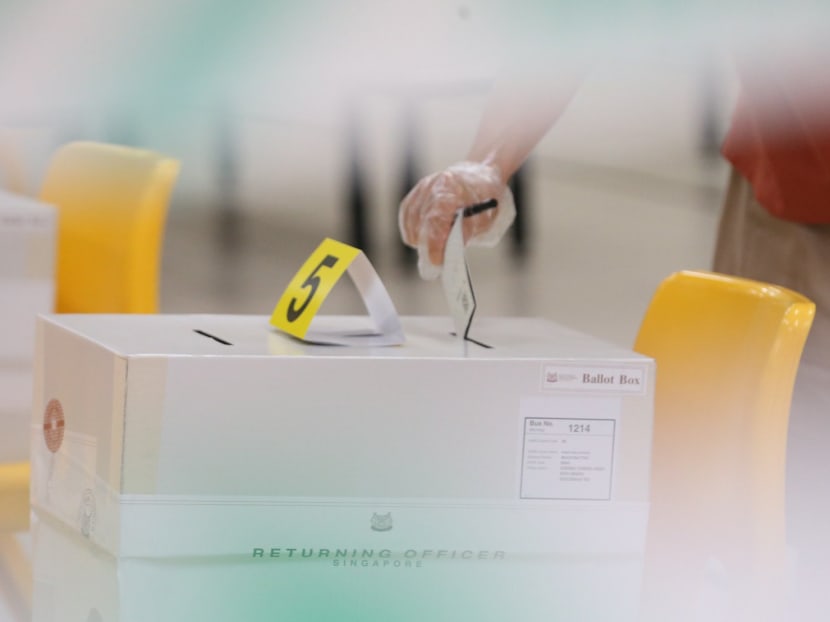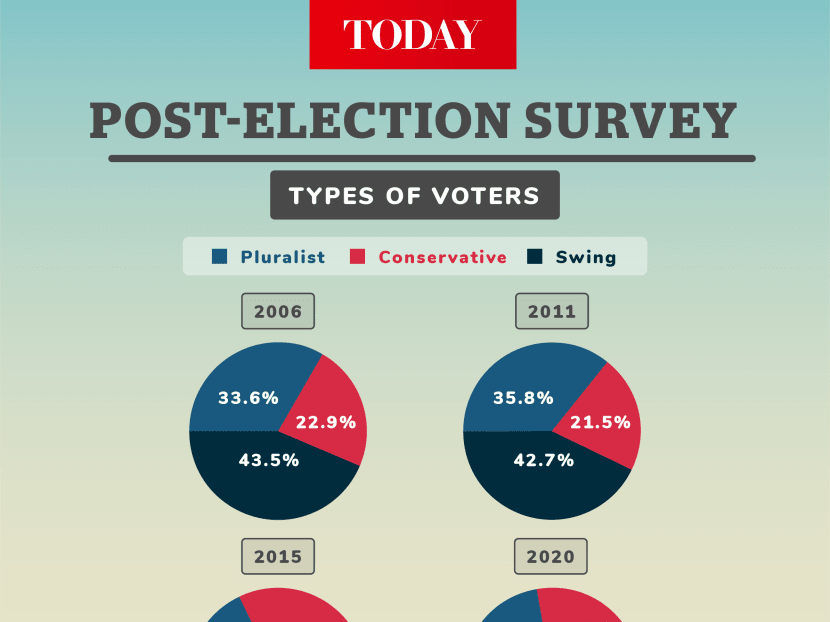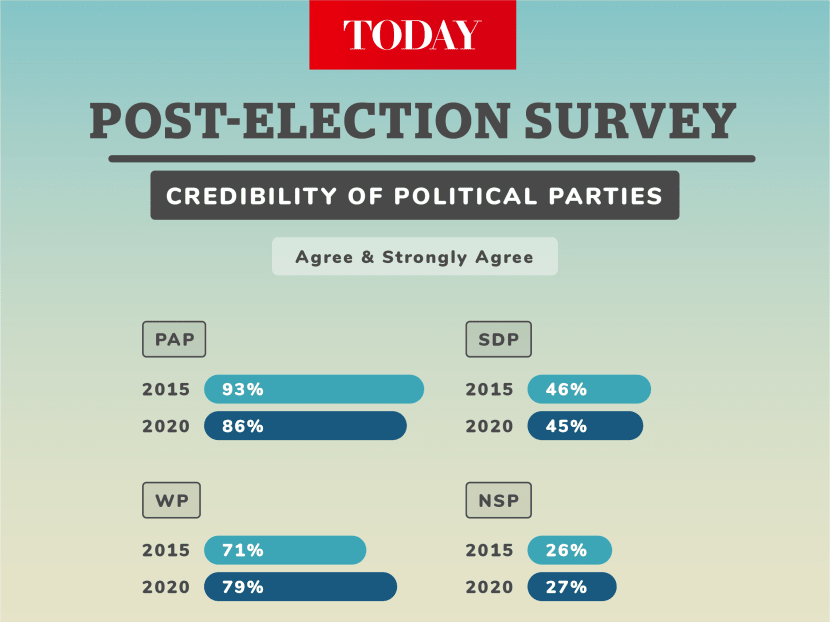Fewer GE2020 voters were ‘conservative’, with 3 in 5 classed as ‘swing’ voters: IPS survey
SINGAPORE — Voters classed as “conservative” shrank to their lowest level since 2006 in the recently concluded General Election (GE), a post-election survey by the Institute of Policy Studies (IPS) found, showing that support for political pluralism could be back on an upward trend following a dip in 2015.

This was the fourth time that IPS had conducted post-election surveys to understand voter attitudes and behaviours.
- Conservative voter group in GE 2020 at its smallest since GE2006, swing voter group was at its largest
- Issues voters cared for the most included government aid for the needy and whether public policies were fair
- These weighed heavier on voters’ minds than Government’s handling of Covid-19
- PAP’s credibility score dropped 7 percentage points to 86% but it remained the most credible; WP’s increased by 8 percentage points to 79%
SINGAPORE — Voters classed as “conservative” shrank to their lowest level since 2006 in the recently concluded General Election (GE), a post-election survey by the Institute of Policy Studies (IPS) found, showing that support for political pluralism could be back on an upward trend following a dip in 2015.
The think-tank also found that issues weighing most on the minds of voters not belonging to this group — that is, the “swing” and “pluralist” voters — are the need for checks and balances in Parliament, the need for different views in Parliament, and the need for an efficient government.
The study defined conservative voters as those who disagree that there is a need for change in the electoral system, checks and balances, and different voices in Parliament.
They accounted for just 18.5 per cent of the voters, falling sharply from 44.3 per cent in 2015. In 2006 and 2011, they accounted for 22.9 per cent and 21.5 per cent of voters respectively.
On the other hand, the group of “swing” voters, defined as those with an eclectic mix of views, was at its highest level since 2006. IPS said that they accounted for close to three in five voters (59.2 per cent), up from 43.5 per cent in 2006, 42.7 per cent in 2011, and 37.8 per cent in 2015.

This was the fourth time that IPS had conducted post-election surveys to understand voter attitudes and behaviours, but it was the first time it had tapped the views of Singaporeans via their mobile phones and through the internet. In the past, it had typically gathered views by calling landlines.
With this, the views of about double the usual number of Singaporeans aged 21 and above — more than 4,000 people — were sought. They were approached between July 11, the day after the polls, and Aug 21.
Besides being quizzed on which issues were important in shaping their voting decision, they were asked for their opinion on how credible they viewed the six best performing political parties that featured in this GE, and what traits they looked out for in a candidate.
PARTY CREDIBILITY

PAP was still seen as the most credible among the political parties, although there was a 7-percentage-point slide from 93 per cent in 2015 to 86 per cent in 2020 in the respondents who agreed or strongly agreed that it was credible.
PAP lost credibility among all age groups, with the largest percentage point drop seen in the 40 to 49 age group.
When other demographic factors were considered, there were drops in its ratings among:
Those whose monthly household income belong to the low- to low-middle income bands (S$0 to S$4,999 a month)
Those living in one- to three-room government-built flats
Men
The Workers’ Party (WP) experienced a credibility boost, gaining eight percentage points among those who “agreed” and “strongly agreed” that it was credible. The figure went from 71 per cent in 2015 to 79 per cent in 2020.
The percentage of those who “strongly agreed” that WP was credible shot up from 8 per cent in 2015 to 20 per cent this year.
IPS said that the opposition party managed to capture both ends of the socio-economic spectrum. Respondents in the highest occupation class — professionals, managers, executives and technicians (PMETs) — as well as those living in the lowest housing category found WP credible.
Generally, there were increases in WP’s ratings among:
Those aged between 30 and 34
Seniors
PMETs
Those with only post-secondary educational qualifications
Those living in one- to three-room government-built flats
Women
The Progress Singapore Party (PSP) came in third in terms of credibility, despite it being new to the political scene. It was more credible to men, those aged between 21 and 39, PMETs, the middle-middle income group earning a salary of S$5,000 to S$6,999 a month, and new or first-time voters.
The new Peoples Voice party came in last among the six parties, with a positive credibility rating of 26 per cent. It was more credible to females, those aged between 40 and 54, the working or intermediate class, the low- or low-middle income group earning under S$5,000 a month, as well as new or first-time voters.
The Singapore Democratic Party (SDP) made the greatest stride among parties that have existed since 2006. While it used to hold a positive credibility rating of only 19 per cent then, it now has a positive rating of 45 per cent.
When considering candidates, the top traits voters look for, in order, are:
Honesty: This mattered especially to PMETs, those in the upper-middle income bracket earning S$7,000 and above, those with a diploma and university education, and private property dwellers.
Being a “fair person”: Across all traits, this saw the greatest jump in “very important” rating compared with GE2015. It mattered especially to 21- to 29-year-olds and diploma holders.
Being “hardworking or committed”: This mattered especially to Malays and Indians, as well as diploma holders and those with a secondary school education.
POLITICAL PLURALISM
The “pluralist” group, defined as those who agree that there is a need for change in the electoral system, checks and balances and different voices in Parliament, grew from 18 per cent in 2015 to 22.4 per cent.
In 2011, this group accounted for a much heftier 35.8 per cent of voters.
While the highest proportion of pluralists was still found among respondents in the youngest age band and the highest socio-economic groups — in line with past trends — IPS said that this GE was different in that there were rises in the proportion of pluralists from different socio-economic groups:
7.2 per cent more pluralists emerged among those earning a low monthly household income of under S$1,999 a month
8.2 per cent more pluralists emerged from those with only post-secondary qualifications
They are the groups with the largest increases in the proportion of pluralists across household income bands and education levels respectively.
With this, IPS concluded that those at the other end of the socio-economic spectrum were feeling the need for political opposition in Parliament to address certain bread-and-butter issues, given the difficult economic conditions surrounding GE2020.
Giving her take on this, Dr Gillian Koh, deputy director of research at IPS, said: “Somewhere within the low- to low-middle income band, you will find (voters who felt) that the job situation arising from Covid-19 pandemic really was a challenge to their sense of security.
“Some would have responded by feeling that they may want to support checks and balances and diverse voices in Parliament, and may have therefore accounted for the shift away from support to the PAP and to the political opposition.”
WHAT’S NEXT FOR THE POLITICAL PARTIES
During a panel discussion moderated by Dr Koh on the survey findings, independent scholar Derek da Cunha said that for PAP to regain part of the popular vote it lost, it has to “address concretely the serious concerns that led some voters to move away from the party during GE2020”.
These concerns include ensuring wages keep up with the rising cost of living, improving job security, and coming up with a viable solution for the lease decay of Housing and Development Board flats.
Another panellist, Dr Lam Peng Er, a senior research fellow at the East Asia Institute, warned that PAP may lose its two-thirds majority if it does not relate better with the younger, better-educated and more demanding electorate.
Younger voters will not just be concerned with material issues, but also harbour aspirations of having a louder voice in governance and seek greater pluralism, fairness and equality, he said.
“The Singapore system must remain fair and seen to be fair by the masses… public policy must be effective and fair to mitigate against rising social and economic inequality.”
As for WP, Dr Lam predicts that should the party continue working hard in the grassroots and in Parliament, it would likely retain its three constituencies, and may even gain new ground.
“Given the twin trends of demographic change (to) political pluralism and the rising credibility of the WP, it is not inconceivable that it may win another Single Member Constituency (SMC) or GRC,” he added.
Agreeing, Dr da Cunha said that even if PAP fights back at the next election, WP will “not be too adversely affected”.
This is because it has an “effective localised strategy” concentrated largely on the east of the island.
As for Dr Tan Cheng Bock’s PSP, Dr da Cunha said that its main challenge would be to ensure that its two non-constituency MPs — Ms Hazel Poa and Mr Leong Mun Wai — are able to return to Parliament and take other candidates with them.
However, this would be a challenge, as the party “lacks branding”, having no elected MPs.
As for SDP, Dr Lam said that it “did very well”, considering it is “left of centre”. It won 46.2 per cent of the vote in Bukit Panjang SMC and 45.2 per cent of the vote in Bukit Batok SMC.
“(SDP) did have some appeal to a significant segment of the Singapore electorate, so let’s not rule it out; it has its niches,” he said.
As for the other parties, Dr da Cunha said that even with the ubiquity of social media, they will not have enough publicity to mount a strong fight in the next elections.
This is because the mainstream media will likely focus their attention on the parties with a presence in Parliament.








